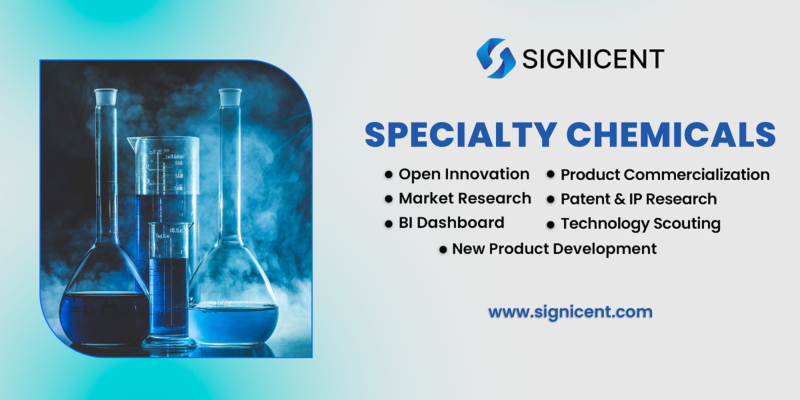“Specialty chemicals or performance chemicals or formulation chemicals” are those chemicals that are used based on their functionality. There is a miscellaneous range of high-value chemicals or materials that are formulated to provide certain functions, enhancing the performance of products or meeting the specific requirements of the users. They are offered based on functioning rather than composition and are utilized in a variety of sectors including automotive, aerospace, agricultural, construction, drinks, food, pharmaceutical, and many more. Some of the categories of these chemicals are adhesives, agrichemicals, cleaning materials, colors, cosmetic additives, etc. Their manufacturers sell not only chemicals but an entire product solution, so specialized marketing and technical service are integral to a specialty chemicals business.
Various factors, including changing consumer preferences, growing disposable incomes, and an increasing focus on healthy and modified products, are driving the demand to increase day by day.
It is an emerging technology, helps to meet the increasing demand for products that are fresh, healthy, and natural.
Green chemistry: The industry’s increasing focus on sustainability and environmental responsibility has led to the emergence of performance chemicals based on green chemistry principles.
Nanotechnology: The integration of nanoscale materials has been employed to enhance the performance and properties of formulation chemicals significantly.
Biotechnology: Producers utilize biological processes to create formulation chemicals with enhanced characteristics and functionalities.
Along with the above technologies, formulation chemicals are useful in other technologies like functional coatings, and advanced chemical industries as well. These technologies within the formulation chemicals sector effectively address specific challenges, elevate overall performance standards, and aligned with the ever-evolving demands of the consumers.
The objective of this study is to conduct technology research to identify innovative technologies in the specialty chemicals domain, which embraces innovative inventions and products. This report will cover the following deliverable insights:
- Technology Research: Latest innovations and trends provide brief detail about the recent technologies and ideas available in the form of research papers, articles, patents, etc. on the specialty chemicals industries, including R&D groups, institutes, etc.
- Competitive Intelligence: Key players, Collaborations, or start-up companies working in this domain.
- Market Research: Market segmentation and market insights focused on this domain.
What are the problems faced in this sector?
The specialty chemicals in the various sectors can yield several adverse consequences. These chemicals may result in significant challenges. These are describe below:
- The challenges faced during the N-formylation reaction for DMF synthesis include the requirement for extremely high pressure, the addition of alkali, solvent, and reducing agent, challenges in catalyst recovery and DMF separation, low catalytic efficiency, and the high cost and sensitivity of phosphine ligands in homogeneous catalytic systems. Despite efforts with stable heterogeneous nitrogen heterocyclic carbene iridium polymer materials, achieving the desired conversion number for industrial production remains a significant challenge.
- Biobased and biodegradable polymers possess mechanical properties that are relatively very less than non-biodegradable polymers.
- Most phenolic resins do not work with water-based latex compositions, making it challenging to add adequate phenolic resin content to existing latex compositions in a way that keeps the phenolic resins stably disseminated for long periods.
Innovative Solutions to the above problems:
To overcome the above challenges in the specialty chemicals sector, companies can implement the following solutions:
- A method is developed to synthesize formamide compounds utilizing a porous organometallic polymer (POMP) catalyst. This catalyst possesses a stable structure, allowing for convenient synthesis, and demonstrates high catalytic efficiency, excellent selectivity, and broad substrate applicability. The POMP catalyst efficiently facilitates the hydrogenation of CO2 under mild reaction conditions.
- Particulate fillers are incorporated into the bio-polymer to improve the mechanical strength and properties of biodegradable polymers.
- Preparing a coating composition with an inverted aqueous dispersion (containing polymers with polar, hydrophilic groups), a phenolic resin, and a latex composition, and then combining the latex composition and the aqueous dispersion to produce the coating composition.
Products:
POLYSORB® – HIGH PURITY ISOSORBIDE
- A highly pure dianhydrohexitol, also known as isosorbide introduced by Roquette.
- This isosorbide is a sustainable, biodegradable, non-aromatic, bicyclic diol derived from the dehydration of sorbitol, a starch derivative.
- It is devoid of bisphenols such as BPA, BPS, and BPF.
- Isosorbide modifies the properties of polymers like polyethylene terephthalate, polycarbonates, polyurethanes, and epoxy resins.
- It has properties like, chemical resistance, UV resistance, scratch resistance, bending resistance, and transparency.
BIOSPHERE BIODEGRADABLE ADDITIVES
- Biosphere biodegradable additives composed of microbes allow microorganisms to consume the plastic articles that have incorporated the additives into their plastic package or product.
- Once the biodegradable additives have homogenized with the plastic polymer the additive reacts with the enzymes to reduce the polymer chain.
- The microorganisms consume the polymer to convert the plastic into CO2, CH4, biomass, and H2O.
- Biosphere biodegradable additives are found in polypropylene, polystyrene, ethylene, and terephthalate.
- These additives also work in plastic polymer prepared using an injection molded process.
Each year Signicent provides consultancy to hundreds of organizations to help transform their innovations to value.
Key Players working in this domain:
This section of the report focuses on competitive intelligence to find the topmost key-player companies working in the sector. The performance chemicals sector comprises numerous key players.
- Henkel Adhesives Technologies India Private Limited: Company specializes in adhesives, sealants, and functional coatings, offering injectable thermally conductive adhesives for EV battery systems and serving various industries, including specialty chemicals.
- BASF: A German multinational company and the largest chemical producer in the world, with a diverse portfolio that includes chemicals, plastics, performance products, crop protection, and oil and gas.
- Dow Chemical Company: A global leader in the formulation chemicals industry, providing innovative and sustainable solutions across a wide range of sectors including agriculture, consumer care, packaging, and transportation.
- Clariant: A prominent global formulation chemicals company, that places strong emphasis on various technologies like energy efficiency, renewable raw materials, preservation of finite resources, and emission-free mobility.
The specialty chemical industry has witnessed the emergence of several start-ups in recent years, driven by technological advancements, growing demand for sustainable solutions, and lucrative market opportunities in different segments. Startups focus on innovation, developing pioneering products and disrupting established processes. For instance, a US-based startup “Alchemy” provides cloud-based software-as-a-service (SaaS) solutions for streamlining specialty chemical development. Their digital business software empowers laboratories to accelerate the creation of new industrial chemicals.
Market segmentation:
The objective of this section is to conduct market research, i.e., on the market segmentation in the specialty chemicals industry. Specialty chemicals can be classified based on product type, end-use industry, and geography.
Product Type:
- Specialty polymers and resins
- Specialty coatings and additives
- Specialty adhesives and sealants
- Others
End-use Industries:
- Automotive and Transportation
- Healthcare and Pharmaceuticals
- Personal care and Cosmetics
- Agriculture and Agrochemicals
- Others
Geography:
- North America
- Europe
- Others
Market Insights:
- The worldwide speciality chemicals market was anticipated to be worth $650.0 billion in 2022, with forecasts indicating that it might reach $953.9 billion by 2027, with a compound annual growth rate (CAGR) of nearly 5.0% from 2022 to 2027.
- The industrial and construction sectors are the primary drivers of the market, with rising demand from the electrical and electronics sectors in recent times.
- The specialty chemicals market grows due to increasing demand in the agrochemical sector, rapid industrialization, and environmental concerns. The global population and food demand for agrochemicals drive crop production, while investments in construction and infrastructure make these countries attractive destinations for specialty chemical manufacturers. Environmental concerns and regulatory focus on health and environmental issues also contribute to the market’s growth.
- The integration of digital technologies, data analytics, and automation is transforming the specialty chemicals industry. Companies are leveraging digital solutions for improved process efficiency, supply chain optimization, and predictive analytics.
- The world economy has suffered significantly as a result of the COVID-19 epidemic. The pandemic has affected almost all countries, leading to lockdowns and containment measures that have disrupted global supply chains, and weakened demand for goods and services.


